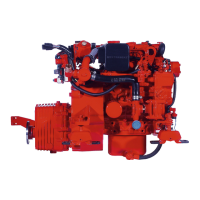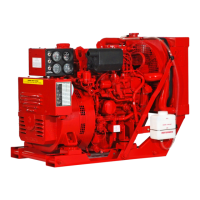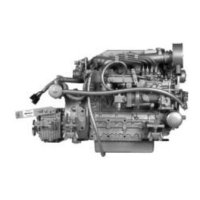STARTER
MOTOR
DESCRIPTION
The
starter
is
a new
type,
small,
light-weight and is called a
high-speed internal-reduction
starter.
The pinion shafris
separate
from
the
motor
shaft;
the
pinion
~lides
only
on
the
pinion
shaft.
A rednction
gear
is
installed
between
the
motor
shaft
and
a pinion
shaft.
The
pinion sliding part
is
not
exposed
outside the
starter
so
that
the
pinion
may
slide
smoothly without
becoming
fouled
with
dust
and
grease. The
motor shaft
is
supported
at
both
ends
on
ball bearings. The
lever
mechanism,
switch
and
overrunning
clutch
inner circuit
are identical
to
conventional
ones.
TERMINALS-""-~
...
,.,..
...
MOTOR
TYPICAL
,
STARTER
MOTOR
REFER
TO
THEW/RING
DIAGRAM
IN
THIS
MANUAL
TROUBLESHOOTING
SOLENOID
A
WARNING:
The
following
emergency
starting
procedures
must
not
be
used
with
gasoline
engines.
Sparks
could
cause
an
explosion
and
fire.
Prior
to
testing, make
certain
the
ships
batteries
are
at full
charge
and
that the
starting
system wiring connections
(terminals)
are clean
and
tight.
Pay particular attention
to
the
'ground
wire
connections
on
the engine
block.
To
check
the
wiring, try
Cfl",c'dng
the starter for a
few
seconds,
never more
than
10
,seconds
at
a
time,
then
run
your
hand
along
the wires
and
terminals
looking for warm
spots
that indicate resistance,
Repair
or
replace
any
trouble
spots,
Using
a multimeter,
test
the
voltage between
the
positive
terminal
stud
on
the start
solenoid
and the
engine
block
(ground).,
If
you
read 12 volts, the starter is faulty.
IGNITION
TERMINAL
[r~---(M)
TERMINAL
To
test
the
ignition circuit,
locate
the
ignition(s) terminal (it
is
one
of
the
small terminal
studs
and
is wired
to
the
ignition
circuit).
Use
a screwdriver, don't
touch
the
blade,
to
jump
from that ignition terminal
to
the
positive battery connection
terminal
on
the solenoid.
If
the starter cranks, the fault
lies
with
the
ignition
circult.
'
If
the solenoid clicks bnt nothing happens, the starter
motor is probably faulty.
~
SOLENOID
'AI''h'"--_(+)
POSITiVE
'TERMINAL
.
r~--(M)
TERMINAL
IGNITION
,
TERMINAL
~
If
nothing hapF"ns
at
all, the solenoid is not getting
cnrrent
..
Check the battery
isolation
switch
and
inspect the
wiring
connections.
it
is
also
possible that the solenoid is
defective,
.
A
WARNING:
There
will
be
arching
and
sparks
will
fly.
when
jumping
terminals.
Be
certain
the
engine
space
Is
free
of
potentially
BJi#lloslve
fumes,
especially
gasoline,
and
tirat
there
are
NO
flammable
solvents
or
materials
stored
nearby.
-..v
WESTERBEKE
Engines & Generators
29

